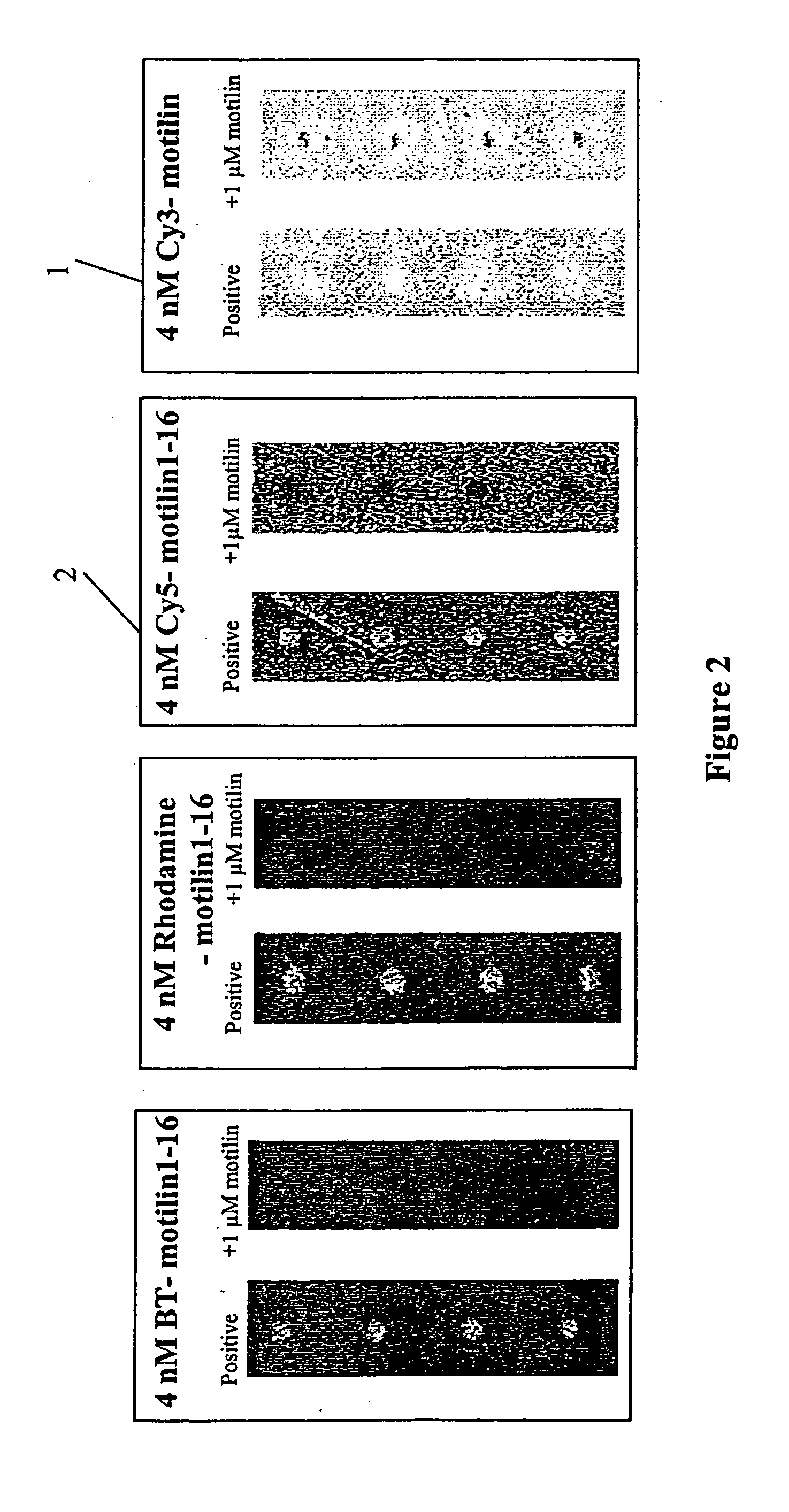Fluorescent ligands for GPCR arrays
a technology of fluorescent ligands and arrays, which is applied in the field of ligand materials, can solve the problems that labeled ligands are not well suited for gpcr microarray applications, and the industry has not fully realized the potentials of gpcr microarrays for drug discovery, and achieve the effect of robust gpcr microarray applications
- Summary
- Abstract
- Description
- Claims
- Application Information
AI Technical Summary
Benefits of technology
Problems solved by technology
Method used
Image
Examples
example 1
[0049] Fluorescently Labeled Motilin 1-16 for Motilin Receptor: Motilin is a 22-amino acid peptide hormone expressed throughout the gastrointestinal tract of human and other species. The cDNA encoding the human motilin receptor (originally isolated as orphan clone GPR38) was identified in 1999 using a deorphanized approach. The amino-terminal portion of motilin, including residues 1-9, is devoid of any activity, while extension of this domain beyond the first nine residues restores binding and biological activity. Thus, the pharmacophoric domain of this hormone represents its amino-terminal decapeptide. The carboxyl-terminal region of motilin forms an α-helix that is thought to stabilize the interaction of the critical amino-terminal residues at the active site of the receptor. However, minimal length of motilin fragments that retain the high binding affinity of native molitin is motilin 1-14.
[0050] We have found out that Cy3-labeled native motilin, as illustrated in FIG. 1, gave r...
example 2
[0061] Cy5-naltrexone for Delta2 Opioid Receptor: The μ and delta2-opioid receptor plays a critical role in analgesia. One of the common antagonists that have been used to define and characterize these receptors is naltrexone, a nonaddictive drug that has been used for the treatment of opioid addiction. The fluorescent derivative, fluorescein-naltrexone, has been reported to bind to the μ-opioid binding site with high affinity, permitting their visualization in Chinese hamster ovary (CHO) cells containing transfected receptors. The fluorescein-naltrexone (FL-naltrexone), the structure of which is illustrated in FIG. 8, is commercially available from Molecular Probes, Inc. of Eugene, Oreg.
[0062] We initially used FL-naltrexone as a probe for mu and delta2 receptors in the microarrays. However, due to the poor photostability of fluorescein and the instrinitic fluorescence signals of membrane microspots in the FITC channel, we did not achieve acceptable assay performance using FL-nalt...
example 3
[0065] Cy5-neurotensin 2-13 for NTR1 Receptor: Neurotensin, natural agonist of human neurotensin receptor subtype 1 (NTR1), is made up of 13 amino acids. A number of studies (see, for example, Feng H J, Zaidi J, Cusack B, et al. (2002) Synthesis and biological studies of novel neurotensin(8-13) mimetics, Bioorgan. Med. Chem. 10, 3849-3858) have shown that the last six C-terminal amino acids of this peptide are all that is needed to activate potently neurotensin receptors. Based on these studies, we have synthesized Cy5-neurotensin 2-13 by using amine-reactive fluorescent dyes from commercial vendors (i.e., Molecular Probes, Eugene, Oreg.; or Amersham Biotech, Piscataway, N.J.). The labeling reaction was done by treating solutions of the peptides in bicarbonate or phosphate buffer with solutions of N-hydroxysuccinimidyl (NHS) derivatives of the fluorescent dyes in DMSO, as recommended by these commercial vendors' protocols. The pH value of the reaction solution plays a crucial role i...
PUM
| Property | Measurement | Unit |
|---|---|---|
| water contact angle | aaaaa | aaaaa |
| molecular weight | aaaaa | aaaaa |
| pH | aaaaa | aaaaa |
Abstract
Description
Claims
Application Information
 Login to View More
Login to View More - R&D
- Intellectual Property
- Life Sciences
- Materials
- Tech Scout
- Unparalleled Data Quality
- Higher Quality Content
- 60% Fewer Hallucinations
Browse by: Latest US Patents, China's latest patents, Technical Efficacy Thesaurus, Application Domain, Technology Topic, Popular Technical Reports.
© 2025 PatSnap. All rights reserved.Legal|Privacy policy|Modern Slavery Act Transparency Statement|Sitemap|About US| Contact US: help@patsnap.com



